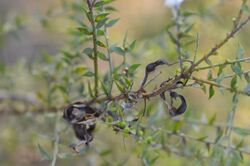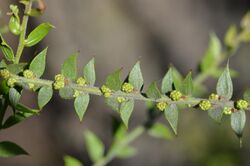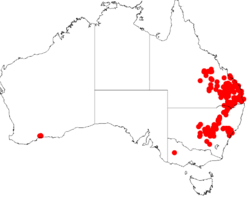Biology:Acacia amblygona
| Fan wattle | |
|---|---|

| |

| |
| Scientific classification | |
| Kingdom: | Plantae |
| Clade: | Tracheophytes |
| Clade: | Angiosperms |
| Clade: | Eudicots |
| Clade: | Rosids |
| Order: | Fabales |
| Family: | Fabaceae |
| Subfamily: | Caesalpinioideae |
| Clade: | Mimosoid clade |
| Genus: | Acacia |
| Species: | A. amblygona
|
| Binomial name | |
| Acacia amblygona | |

| |
| Occurrence data from AVH | |
Acacia amblygona, commonly known as fan wattle or fan leaf wattle,[1] is a shrub belonging to the genus Acacia and the subgenus Phyllodineae that is native to Australia.
Description
The bushy and prickly shrub typically grows to a height of 0.4 to 1.5 metres (1 to 5 ft)[3] with an erect or decumbent habit. The branchlets are terete with fine ridges and light to densely hairy. The sessile phyllodes have an ovate to lanceolate or elliptic shape and are 0.8 to 1.5 centimetres (0.31 to 0.59 in) in length and 2 to 4 millimetres (0.079 to 0.157 in) wide.[1] It blooms from July to October and produces yellow flowers.[3] The simple axillary inflorescences have globose heads containing 12 to 18 bright yellow flowers and have a diameter of 4 to 6.5 mm (0.157 to 0.256 in). Following flowering curved to twisted seed pods form with a length of 3 to 7 cm (1.2 to 2.8 in) and are 3 to 5 mm (0.118 to 0.197 in) wide.[1]
Taxonomy
The species was first formally described in 1842 by the botanist George Bentham in William Jackson Hooker's Notes on Mimoseae, with a synopsis of species published in the London Journal of Botany. The species was reclassified in 1987 by Leslie Pedley as Racosperma amblygonum then transferred back into the genus Acacia in 2001.[4] Other synonyms include Acacia nernstii.[4]
Distribution
In Western Australia it is native to an area along the south coast near Ravensthorpe in the Goldfields-Esperance region of Western Australia where it grows in stony soil.[3] It is found in coastal and inland parts of New South Wales north from Lake Cargelligo and extends into southern parts of Queensland.[1]
See also
References
- ↑ Jump up to: 1.0 1.1 1.2 1.3 1.4 "Acacia amblygona A.Cunn. ex Benth.". PlantNet. Royal Botanic Gardens, Sydney. http://plantnet.rbgsyd.nsw.gov.au/cgi-bin/NSWfl.pl?page=nswfl&lvl=sp&name=Acacia~amblygona.
- ↑ Hooker, W.J. (1842). "Notes on Mimoseae, with a synopsis of species". London Journal of Botany 1: 332. https://biodiversitylibrary.org/page/10610812.
- ↑ Jump up to: 3.0 3.1 3.2 "Acacia amblygona". FloraBase. Western Australian Government Department of Parks and Wildlife. https://florabase.dpaw.wa.gov.au/browse/profile/16895.
- ↑ Jump up to: 4.0 4.1 "Acacia amblygona A.Cunn. ex Benth. Fan Wattle". Atlas of Living Australia. Global Biodiversity Information Facility. https://bie.ala.org.au/species/http://id.biodiversity.org.au/node/apni/2917570#names.
Wikidata ☰ Q15289641 entry
 |

